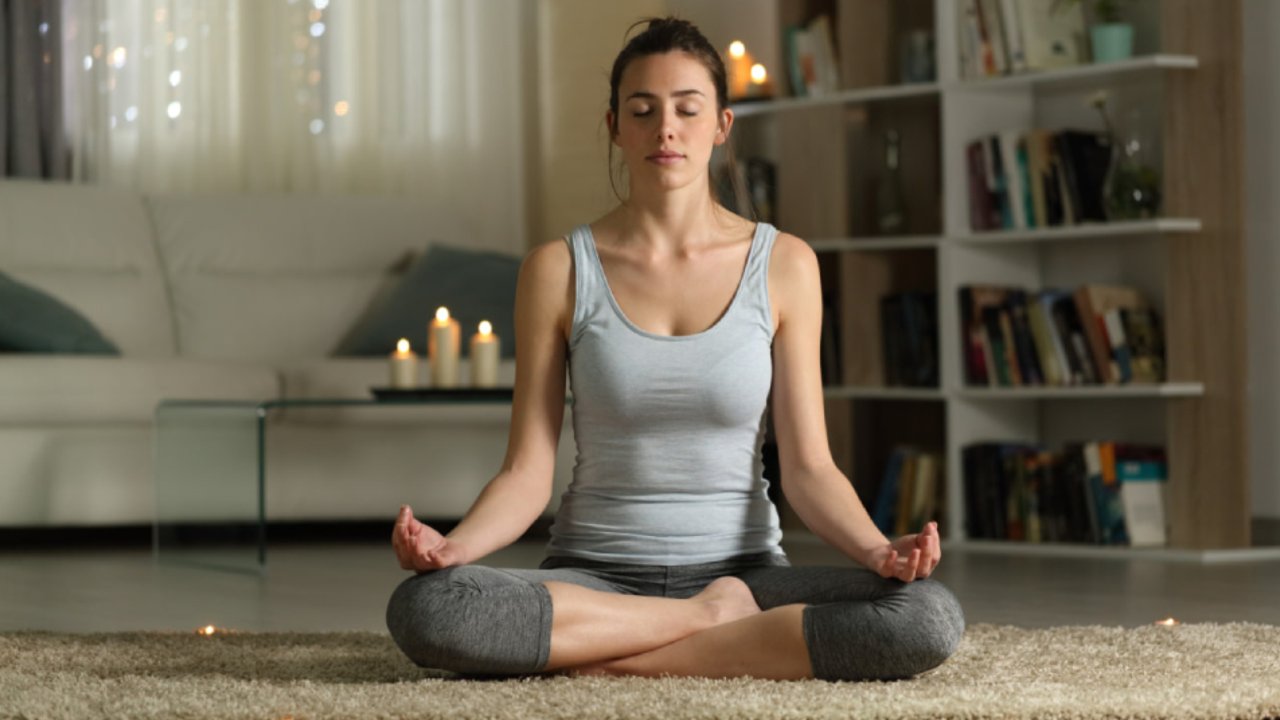How to Meditate: 7 Techniques to Relax & Improve Your Health
Reconditioning and improving both your mental and physical health through meditation is simpler than you might think. With the power of your mind, you can cultivate a deeper sense of well-being. There are straightforward techniques and practices that can help you learn how to meditate effectively. 
Meditation is not just about sitting in silence; it’s a tool to quiet the mind, reduce stress, and enhance overall health. But the real question is: why should you meditate, and how do you begin? Meditation offers a range of benefits, from improving focus and emotional stability to boosting your immune system and increasing self-awareness.
By incorporating meditation into your daily routine, you can create positive shifts in your mental and physical state. The key is to start with simple techniques and make meditation a consistent practice in your life.
Why Meditate?
When we’re stressed, our mind is like a mountain hidden in fog—unclear and overwhelmed. Meditation is like the wind that clears the fog, revealing the calm, blue sky beneath. Integrating meditation into your daily routine is just as important as any medicine, though it’s often overlooked.
Just like you take care of your body with daily showers, exercise, and relaxation, meditation offers your mind the care it needs to function at its best. Below are some ways to meditate and keep both your mind and body healthy.
1. Choose the Right Environment
Creating the right environment for meditation is essential, especially for beginners. A peaceful setting helps calm your mind and improves your ability to focus. Here’s how you can optimize your space:
a. Select a Quiet, Distraction-Free Space
- Beginners need a quiet and peaceful space where external distractions are minimal. Choosing a room with little to no background noise helps you focus.
- Avoid spaces that may cause interruptions or tempt you to look at objects around the room, which could distract your mind.
b. Consistency is Key
- Try to meditate in the same place each time. This helps condition your mind to associate the space with relaxation and mindfulness.
- Creating a routine in a familiar setting can make meditation feel like a natural part of your day.
c. Create a Relaxing Atmosphere
- Enhance the ambiance by adding calming elements like a soft rug, scented candles, or dim lighting to help set a tranquil mood.
- Consider adding a small plant or other natural elements to create a serene space.
d. Wear Comfortable Clothes
- Wear loose, comfortable clothing that allows you to sit in a relaxed position. Avoid clothes that feel tight or restrictive.
- It’s also important to remove shoes to avoid feeling discomfort or being too aware of your feet.
e. Use Instrumental Music or Sounds
- When using background music, opt for instrumental music or nature sounds, which can be soothing and enhance focus.
- Avoid music with lyrics as the words may interfere with your concentration and bring your thoughts elsewhere.
2. Find the Right Time
The time of day when you meditate can greatly influence your experience and the benefits you receive from the practice. Choosing the right time depends on your personal goals and lifestyle. Here are some insights to help you determine the best time for your meditation practice:
a. Morning Meditation for a Positive Start
- Meditating in the morning can set a positive tone for the day. It helps clear your mind, increases focus, and prepares you mentally to face the challenges ahead.
- Starting the day with meditation promotes a sense of calm and balance, allowing you to approach tasks with a clear and centered mind.
b. Midday Meditation to Recharge
- A short meditation session during the middle of the day can help re-energize you and reduce any stress or fatigue you may have accumulated.
- It serves as a “reset button,” helping to refocus your mind and body so that you can continue your day with more energy and clarity.
c. Evening Meditation for Restful Sleep
- Meditating at night helps you unwind from the day’s stress and allows you to release mental tensions that may hinder restful sleep.
- Evening meditation can be particularly beneficial for those who struggle with falling asleep, as it calms the mind and signals to the body that it’s time to relax.
d. Flexibility: Meditate Anytime, Anywhere
- Once you’re familiar with the meditation process, you can practice it at any time and in almost any location, such as on the subway, at the office, or even at the beach.
- Meditation doesn’t need to be confined to a specific time of day. You can fit it into moments when you feel the need to center yourself or clear your mind.
e. Consistency is Essential
- While flexibility is a great benefit, it’s still important to choose a specific time each day to meditate, especially when you’re starting out. Consistency helps reinforce the habit and improves the depth of your practice.
- Avoid shortening your meditation sessions because they feel too comfortable or extending them if they become difficult. It’s important to stick to a routine that works for you, gradually increasing duration as you build your practice.
3. Choose Your Comfortable Posture
Your physical posture during meditation plays a crucial role in how comfortable and focused you feel. A proper posture not only helps prevent discomfort but also enhances the flow of energy and encourages better concentration. Here’s how to choose a posture that works for you:
a. The Lotus Position (Padmasana)
- The Lotus position is a traditional and highly regarded posture for meditation. In this position, sit on the floor or a yoga mat, cross your legs, and place each foot on the opposite thigh. Your soles should face upwards, which helps create a grounded yet open stance.
- This position promotes stability and balance, allowing the body and mind to remain centered. However, it requires flexibility, especially in the hips and knees.
b. Half Lotus Position
- If the full Lotus position feels too challenging due to flexibility limitations, the Half Lotus is an excellent alternative. One leg is placed flat on the floor while the other leg is rested on the opposite calf.
- This position is gentler on the knees and hips but still offers a stable foundation for meditation.
c. Seated Posture on a Chair
- If sitting on the floor is uncomfortable, you can also meditate while sitting on a chair. Keep your feet flat on the floor, with your knees at a 90-degree angle.
- Ensure that the chair supports your back, and that you sit up straight with your spine aligned to prevent slouching. A chair can be a good option if you have issues with knee or hip flexibility.
d. Kneeling with Support
- Another option is kneeling on a small cushion or meditation bench. This posture can reduce strain on the knees while providing stability.
- Kneeling also encourages a more open chest and spine, promoting deep breathing and improved focus.
e. Maintain a Straight Back
- Regardless of your chosen posture, it’s crucial to maintain a straight spine. Sit tall, slightly arching your lower back to unfold your spine and release tension from the solar plexus.
- This alignment helps prevent back pain and ensures that energy can flow freely through your body. Imagine lengthening the spine as you meditate to avoid stiffness or discomfort.
f. Relax Your Shoulders and Chin
- Keep your shoulders relaxed and slightly back, which helps open up the chest and promotes better breathing.
- Your chin should be slightly tucked in, which helps align the head with the spine and encourages a sense of balance.
g. Acknowledge Discomfort, But Don’t Let It Distract You
- Initially, you may feel some twitching or discomfort in your posture as your body adjusts to the position. This is normal and can be a sign that your muscles are releasing tension.
- If discomfort persists, consider adjusting your posture or using cushions for extra support. The key is to find a balance where you’re comfortable enough to maintain stillness without strain.
4. Relax Before Each Session
Starting your meditation practice with a period of relaxation is essential for preparing both your mind and body. This helps you transition from the busyness of your day into a state of calm, allowing for deeper concentration during meditation. Here’s how to effectively relax before you begin:
a. Begin with Deep Breathing
- Before starting meditation, take a few moments to breathe deeply and calmly. Close your eyes and focus on inhaling slowly through your nose, allowing your belly to expand with each breath.
- As you exhale, release the air gently. This deep breathing helps lower stress levels and centers your mind, preparing you for a calm state.
b. Stretch and Relax Your Body
- Stretching your body before meditation helps release any physical tension that might distract you during your practice.
- Lie on your back or sit comfortably, and gently stretch each muscle group. Pay attention to areas that tend to hold tension, like your shoulders, lower back, and legs.
c. Be Mindful of Your Body’s Connection to the Ground
- While you breathe deeply, bring awareness to the parts of your body that are in contact with the floor or cushion (heels, calves, buttocks, back of the head, palms, etc.).
- Feel the weight of your body pressing down and allow your muscles to relax and release any tightness in these areas. This body awareness can promote a sense of grounding, which is essential for deeper relaxation.
d. Let Go of Mental Tension
- Relaxation isn’t just physical; it’s also mental. As you breathe and stretch, consciously let go of any mental tension. Don’t try to control your thoughts; instead, simply observe them without judgment.
- It’s normal to feel that your mind is filled with random thoughts, emotions, or distractions. Acknowledge them and gently redirect your focus back to your breathing and bodily sensations. This practice will help you let go of mental chatter over time.
e. Recognize the Challenges of the Mind
- As a beginner, you may notice your mind continuously wandering. You may become distracted by negative thoughts, bodily sensations, emotions, or sounds from your environment. This is a natural part of the learning process.
- Your mind is conditioned to focus on negativity and past experiences. The goal of meditation is not to silence these thoughts entirely, but to observe them without getting attached or overwhelmed by them. Over time, your ability to maintain focus will improve.
f. Achieve a State of Deep Calm
- Once you’ve relaxed your body and mind, you should begin to feel a sense of calm and clarity. This feeling may even expand into a sensation of floating or a sense of “losing yourself” in an empty, tranquil space.
- This state of relaxation is the ideal foundation for starting your meditation practice. It creates a mental space where you can enter deeper meditative states, allowing you to focus more fully on your practice.
5. Adjust Your Eyes
The position and openness of your eyes can influence your focus and overall meditation experience. While the ideal eye position can vary from person to person, there are some general guidelines to help you stay relaxed, alert, and connected during meditation.
a. Keep Your Eyes Half Closed or Closed
- One common recommendation is to keep your eyes half-closed during meditation. This subtle gaze helps you stay present, with enough awareness of your surroundings while drawing your attention inward.
- Alternatively, fully closing your eyes can help eliminate distractions and allow you to direct all of your energy towards inner focus and relaxation.
b. Focus on the Interior, Not the Exterior
- The purpose of closing your eyes (or partially closing them) is to shift your attention away from external stimuli and focus on the sensations, thoughts, and feelings that arise within.
- When your eyes are closed, your mind can more easily turn inward, which is a key part of meditation practice, helping to deepen concentration.
c. Close Your Eyes to Minimize Distractions
- If your environment is full of distractions such as bright lights, moving objects, or changing scenery, it’s better to close your eyes. Doing so reduces visual stimuli and allows your mind to become less cluttered.
- Closing your eyes can also help create a sense of privacy and space, which can enhance relaxation and provide a sense of calm.
d. Open Your Eyes if You Feel Drowsy
- If you begin to feel sleepy or your mind starts to drift into a haze, opening your eyes slightly can help you regain focus and alertness.
- A gentle open-eyed gaze, focused downward or on a specific point in the room, can help you stay aware and prevent drowsiness during your practice.
e. Experiment and Find What Works for You
- Every individual has different preferences when it comes to eye position during meditation. Some people may prefer fully closed eyes, while others may find partial closure or even a soft, unfocused gaze more effective.
- Don’t be afraid to experiment with different eye positions and adjust based on how you feel. Over time, you’ll find the eye position that helps you maintain focus and stay alert during your practice.
6. Concentrate on Your Breathing
Breathing is a fundamental and powerful anchor in meditation. It’s the second key pillar after posture and is essential for maintaining focus and deepening your practice. Focusing on your breath helps you stay present, calm your mind, and build mental strength. Here’s how to use your breath as a tool for concentration and meditation:
a. Understand the Importance of Breath in Meditation
- Your breath is an essential part of meditation because it serves as a natural, rhythmic focal point. When you focus on your breath, you bring your attention away from external distractions and internal chatter, making it easier to settle into the present moment.
- Breathing is often described as the “bridge” between the body and the mind. By focusing on it, you create a sense of harmony and connection within yourself.
b. The Anapana Technique: Focus on the Nostrils
- One specific technique used in meditation is called Anapana, which involves focusing on the breath as it enters and exits through your nostrils. Pay close attention to the area where the breath touches, the triangular region from the nostrils to the upper lip.
- This technique helps you develop a fine level of concentration. It’s not about controlling your breath but simply observing it as it flows naturally.
c. Be Aware of Your Breath Without Trying to Control It
- Simply become aware of your breath without trying to force or manipulate it. Let your breath flow naturally, whether it’s shallow or deep, fast or slow.
- This awareness helps to release any tension in the body, especially in the abdomen, and allows you to deepen your sense of relaxation.
d. Use Your Breath to Release Tension
- Focus on the sensations of your breath as it fills your abdomen. With each inhale, allow your belly to expand, and with each exhale, gently release any tension or tightness in your body.
- This not only helps calm the body but also promotes a sense of peace and mental clarity. Breathing deeply into the abdomen can help you feel more centered and grounded.
e. Combat the Distraction of Thoughts
- When thoughts arise and distract you, gently bring your focus back to your breath. This act of redirecting your attention back to the breath is one of the core practices of meditation.
- Over time, this exercise strengthens your ability to remain present and reduces the power that scattered thoughts have over you, helping to create mental discipline.
f. Build Mental Strength and Calm
- Concentrating on your breath doesn’t just calm the mind; it also strengthens your mental focus. By practicing this technique regularly, you train your mind to be less reactive and more resilient to distractions.
- The more you practice, the more you’ll notice that the act of focusing on your breath becomes easier, allowing you to meditate more deeply and for longer periods.
7. Purify Your Mind
The mind plays a crucial role in meditation, and even with perfect posture and breathing, if the mind is not purified, the benefits of meditation can be limited. Purifying the mind is a process that involves mindfulness, awareness, and control over the thoughts and emotions that arise. Here’s how to purify your mind for a deeper meditation experience:
a. Recognize the Importance of a Clean Mind
- A purified mind is essential for effective meditation. When the mind is clouded by negativity, distractions, or unresolved emotions, it becomes harder to focus and find inner peace.
- Meditation isn’t just about sitting still and breathing; it’s about clearing the mental clutter and creating space for stillness and clarity.
b. Understand the Nature of Your Mind
- Begin by observing your mind without judgment. Your mind is constantly generating thoughts, and some of them may be positive, while others may be negative or even troubling.
- Instead of suppressing or fighting these thoughts, allow them to arise naturally. Acknowledge them and then let them pass without becoming attached to them. This non-reactive awareness is key to purifying the mind.
c. Avoid Judging Your Thoughts
- In meditation, it’s important not to judge your thoughts as good or bad, right or wrong. Just observe them as they come and go. The more you try to control your thoughts or force them to stop, the more they will persist.
- View your thoughts as transient and impermanent, much like the images on a screen. Allow them to appear and disappear without getting emotionally involved in them.
d. Accept and Learn from Negative Emotions
- During meditation, you may encounter emotions like anger, fear, shame, or sadness. Rather than pushing them away, allow yourself to feel them fully and without resistance.
- These emotions can be valuable teachers. Use them as opportunities to learn about the root causes of your suffering and the ways in which you can respond more mindfully. Consider invoking antidotes to these negative feelings, such as compassion, patience, or forgiveness.
e. Cultivate Mindfulness and Awareness
- As you meditate, cultivate an ongoing awareness of your thoughts and emotions. Instead of reacting to them impulsively, you practice mindfulness—simply observing what arises and choosing how to respond.
- This mindfulness gradually purifies the mind, helping you to develop a clearer, more focused mental state that can sustain a deeper meditation practice.
f. Return to Breath When Needed
- If you find that your thoughts are overwhelming or your mind is too restless, return to focusing on your breath. The breath serves as an anchor that can bring you back to the present moment and reestablish your concentration.
- This simple act of focusing on your breath can help calm your mind, allowing you to eventually return to the deeper work of purifying your thoughts.
Remember, meditation is a journey that requires patience and consistency. Whether you’re a beginner or experienced, these principles will help build a strong foundation for a lasting practice that benefits your physical, mental, and emotional well-being.

























Really enjoyed this—simple and practical techniques that make meditation feel approachable and effective!